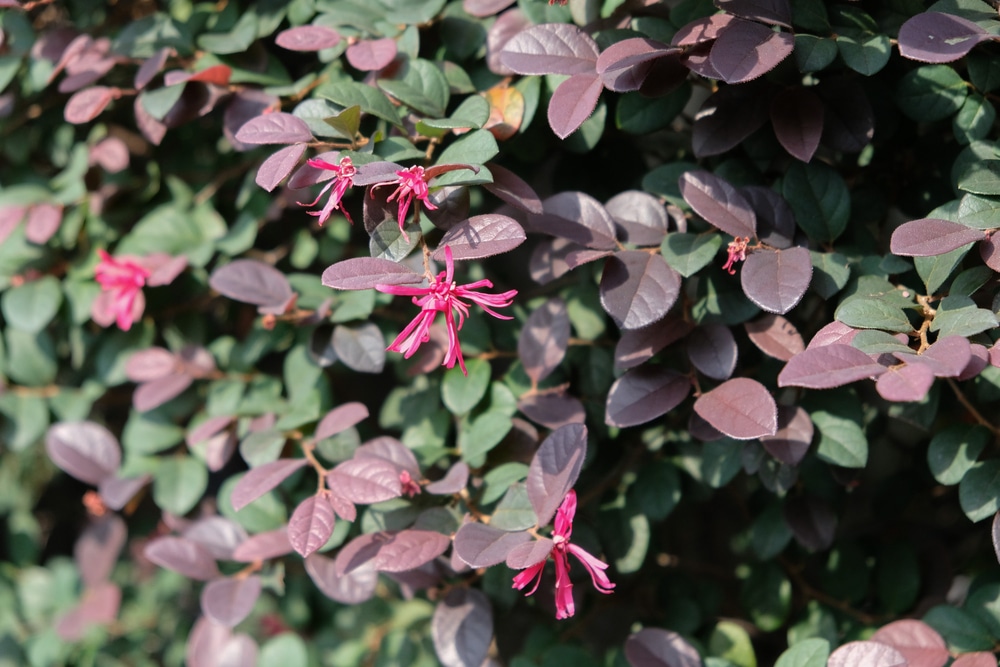Shrubs are one of the most versatile and popular plants that can be used in a landscape. They provide beauty and privacy, and most of the time, they’re low-maintenance. Carolina Midnight Loropetalum is a shrub that has it all – stunning deep purple foliage, deer-resistant, and it’s practically easy to care for.
It’s a showstopper in any landscape and it can be used as a hedging plant, foundation planting, focal point, or as an accent in mixed borders.
| Botanical Name | Loropetalum Chinensis F. Rubrum |
| Common Name | Carolina Midnight |
| Plant Type | Perennial |
| Flower Color | Hot pink to red |
| Size When Mature | 120 – 180 inches tall, 72 – 120 inches spread |
| Bloom Time | Early Spring |
| Sun Requirements | Full Sun to Partial Shade |
| USDA Hardiness Zones | 7 – 10 |
| Soil PH Range | 6.0 – 7.0 |
| Soil Type | Acidic, fertile, well-draining |
| Water Needs | Medium |
| Native Area | China |
What You Need to Know About Carolina Midnight Loropetalum
If you’re looking for dark-colored foliage plants, the Carolina Midnight Loropetalum should be at the top of your list. Its rounded shape and deep purple leaves make it a standout in the landscape. When it flowers in the spring, it produces hot pink blooms that contrast beautifully against its dramatic and dark foliage.
Despite its small flowers, the Carolina Midnight Loropetalum is a heavy bloomer with fragrant blooms.
Its flowers bloom early on during the spring and last for weeks. When the flowers start to fade, the leaves take center stage and provide interest in the landscape all the way until fall.
As a slow grower, this might seem like a good thing for most gardeners as they don’t have to worry about pruning it too often. But because of its slow growth habit, it can take a while for the Carolina Midnight Loropetalum to reach its full potential size of 10 to 15 feet tall.
Often, these plants are grown as tall hedges or foundation plantings. If you’re looking to add some privacy to your landscape, the Carolina Midnight Loropetalum is an excellent plant to use.
How to Care for Carolina Midnight Loropetalum
Here’s everything you need to know about growing and caring for a thriving Carlina Midnight Loropetalum:
Light
Simply one of the best things about this plant is that it can grow in both full sun and partial shade. Afternoon shade is ideal if you’re situated in regions where temperatures reach over 90 degrees Fahrenheit.
Although it does tolerate some shade, the Carolina Midnight Loropetalum will produce the best foliage color in full sun. If it’s grown in too much shade, the leaves will start to develop a slight green tint.
When grown in containers, make sure to place them in an area that receives at least six hours of sunlight per day. Remember to rotate every few days so that all sides of the plant get an equal amount of light.
Water and Soil Needs
During their growing years, Carolina Midnight Loropetalum will need to be watered often. 1-2 times of watering per week is needed to ensure that the roots are getting enough moisture. Once they’re established, they can withstand long periods of drought and can even be considered drought-tolerant. It can withstand without irrigation given that there’s rainfall once every week or two.
When it comes to soil, the Carolina Midnight Loropetalum is not picky and will grow regardless of the soil type. However, this plant will thrive and produce the best foliage color when planted in acidic, organic-rich, and well-drained soil.
Temperature Requirements
If you’re looking for a plant that can survive cold temperatures, the Carolina Midnight Loropetalum is an excellent choice. It’s winter hardy in USDA zones 7-10 and can even tolerate temperatures as low as 10 degrees Fahrenheit. However, bear in mind that it’s not tolerant of salty air and should be protected from salt spray if you live near the coast.
It does better in colder areas than in hotter regions as the leaves can start to scorch when exposed to too much heat and direct sunlight.
Fertilizer
The best fertilizer to use on a Carolina Midnight Loropetalum is an acidic fertilizer with an 8-8-8 ratio, or similar. You can opt for fertilizers formulated for acid-loving plants like hydrangeas to help maintain the ideal soil conditions for your plant.
While it doesn’t require much fertilizer, an annual feeding in the spring will help promote growth. Avoid fertilizers with too much nitrogen. This can result in excessive leaf growth with little to no flowers.
Common Diseases
When grown in ideal conditions, this plant doesn’t suffer from many diseases. However, root rot can be common especially when grown in soils with poor drainage. Remember to aerate the soil around your plant to improve drainage and prevent this disease.
Additionally, pests are not a big problem for this plant too. These plants are left undisturbed by most pests, except for the occasional scale insect. These pests can be removed by hand or with insecticidal soap.
Carolina Midnight Loropetalum Propagation
Because Carolina Midnight loropetalum hedges are ideal, you may want to consider propagating your own plants. The best way to propagate this plant is through stem cuttings taken from new growth in the spring or summer, when the weather is warm and humid.
Take about 4-6 inches of new growth and remove the bottom leaves. Depending on the size of the cutting, you can either use one or two per pot. You may also place it in water for it to root, or you can plant it directly into the soil.
If you’ve decided to keep the stem in water, change the water every few days. This is to prevent bacterial growth. On the other hand, if you’ve decided to plant it directly, remember to keep the soil moist and damp at all times.
Transplant to pots once the roots have grown to about 2 inches long. You can then transfer it to its final location once it’s big and strong enough.


